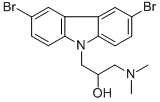Wiskostatin (253449-04-6) is a selective, reversible inhibitor of neural Wiskott-Aldrich syndrome protein (N-WASP) activity1. Binds to the regulatory domain of N-WASP and inhibits activation of Arp2/3 complex by forcing N-WASP into an inactive conformation2. Inhibits PIP2-induced actin polymerization (EC50=4 μM). Wiskostatin perturbs agrin-elicited acetylcholine receptor clustering3. Inhibits the formation of dendritic spines and synapses in hippocampal neurons.
Wiskostatin has been used:
- as a small-molecule inhibitor of Wiskott-Aldrich syndrome protein (WASP) in human osteosarcoma U2OS cells and mouse-tail fibroblast cell lines
- as a neural (N)-WASP inhibitor in cultured neurons and in the human embryonic kidney (HEK293) cells expressing HA-Parkin
- as a neural (N)-WASP inhibitor in dorsal root ganglion (DRG) cells to investigate vascular endothelial growth factor (VEGF) effect on the actin related protein 2/3 complex (Arp 2/3)
ChEBI: 1-(3,6-dibromocarbazol-9-yl)-3-(dimethylamino)propan-2-ol is a member of the class of carbazoles that is 1-(carbazol-9-yl)-3-(dimethylamino)propan-2-ol bearing two additional bromo substituents at positions 3 and 6 on the carbazole ring system. It is a member of carbazoles, an organobromine compound, a secondary alcohol and a tertiary amino compound.
Wiskostatin is a dibrominated carbazole. The N-alkylated side chain has a chiral hydroxyl group and a terminal tertiary amine.
Wiskostatin is a selective inhibitor of N-WASP, a ubiquitously expressed member of the Wiskott-Aldrich Syndrome protein (WASp) family that regulates actin polymerization. Wiskostatin inhibits actin-dependent cellular functions, including migration, transmembrane transport and phagocytosis.
1) Peterson et al. (2002), Small molecules, big impact: a history of chemical inhibitors and the cytoskeleton; Chem. Biol., 9 1275
2) Peterson et al. (2004), Chemical inhibition of N-WASP by stabilization of a native autoinhibited conformation; Nat. Struct. Mol. Biol., 11 747
3) Cartaud et al. (2011), Agrin triggers the clustering of raft-associated acetylcholine receptors through actin cytoskeleton reorganization; Biol. Cell., 103 287
4) Wegner et al. (2008), N-wasp and the arp2/3 complex are critical regulators of actin in the development of dendritic spines and synapses; J. Biol. Chem., 283 15912

